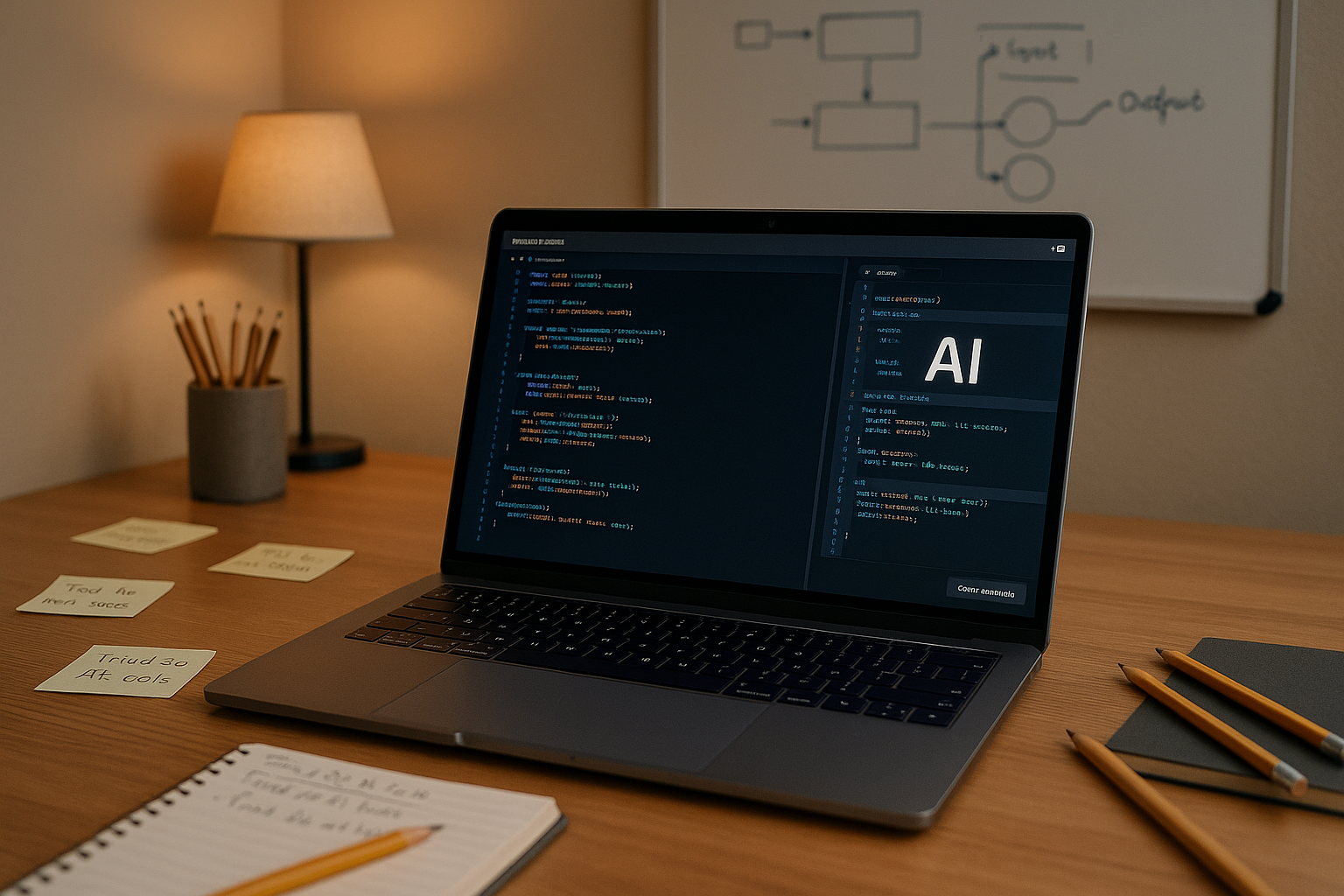Building an AI Feature with Open-Source Models: Cost & Risk Breakdown
Taher Pardawala August 7, 2025
Open-source AI models and proprietary AI solutions each offer distinct advantages and challenges when building AI features. Open-source models provide flexibility, transparency, and cost savings on licensing fees but demand higher upfront investment in talent, infrastructure, and ongoing maintenance. Proprietary solutions, on the other hand, prioritize speed, ease of deployment, and enterprise-grade security but come with higher long-term costs and vendor lock-in risks.
Key Takeaways:
- Open-source AI: Initial costs range from $15,000–$100,000+ for development, with added expenses for data cleaning, integration, and security. Ideal for teams with technical expertise and a need for customization.
- Proprietary AI: Subscription-based pricing starts at $100–$500/month, with enterprise contracts exceeding $500,000 annually. Best for rapid deployment and businesses with limited AI expertise.
- Security: Open-source models require manual security updates, while proprietary solutions offer built-in compliance tools but may lack transparency.
- Scalability: Proprietary vendors handle infrastructure, whereas open-source requires dedicated resources for scaling and maintenance.
Quick Comparison:
| Aspect | Open-Source AI | Proprietary AI |
|---|---|---|
| Upfront Costs | $15,000–$100,000+ | $0 initial; $100–$500/month usage |
| Customization | Full control over code | Limited to vendor features |
| Security | Transparent but self-managed | Vendor-managed, less transparent |
| Support | Community-driven | Dedicated professional support |
| Long-Term Costs | Lower | Higher due to vendor lock-in |
Hybrid Approach: Start with proprietary tools for quick results, then transition to open-source for cost control and scalability. This strategy balances speed, customization, and long-term savings.
Bill Gurley and Sunny Madra talk open-source vs. proprietary AI | E1825
1. Open-Source AI Models
Open-source AI models offer startups a compelling alternative to pricey proprietary solutions, but the financial and operational implications require careful thought. These models are appealing due to their flexibility and transparency, though they come with their own set of challenges.
Cost
While open-source AI removes licensing fees, it introduces significant development and integration expenses.
Initial Investment Requirements
Getting started with open-source AI demands a considerable upfront investment in talent and infrastructure. For instance, building a basic AI proof of concept can cost between $15,000 and $25,000, while developing a full machine learning MVP ranges from $25,000 to $100,000. Custom models can push costs beyond $100,000 [5].
Hidden Implementation Costs
Although companies save roughly 30% on licensing fees, they end up spending 40% more on integration and infrastructure [6]. Why? Open-source models require skilled developers to integrate, optimize, and maintain them.
Data cleaning is another costly aspect. With 66% of companies encountering errors and biases in their training datasets, it can take 80 to 160 hours to clean a dataset of 100,000 samples [7]. These efforts, along with the need for robust security measures, contribute to the overall expense.
Security and Data Privacy
Open-source AI offers both opportunities and risks when it comes to security. The transparent nature of open-source code allows your team to review algorithms, identify vulnerabilities, and implement custom security measures tailored to your needs.
But transparency cuts both ways. While your team can audit the code, so can potential attackers. This means your team must take full responsibility for security updates, patching vulnerabilities, and ensuring compliance. These tasks require ongoing expertise and can add to your operational costs.
On the upside, open-source models give you complete control over your data. Unlike proprietary solutions that may process data on external servers, open-source models can operate entirely within your infrastructure. This control allows you to better manage sensitive information and ensure compliance with data privacy regulations.
Scalability and Maintenance
Scaling open-source AI projects requires dedicated resources to manage growing computational demands, optimize performance, and maintain infrastructure.
The maintenance workload also increases over time. Your team will need to stay on top of model updates, security patches, and performance improvements. Unlike proprietary solutions, where vendors handle these tasks, open-source implementations demand a dedicated team to monitor and enhance performance, troubleshoot issues, and implement updates.
Long-term Resource Planning
The costs of integrating open-source AI models typically start at $100,000 [5], and these costs grow as your project scales. You’ll need to budget for infrastructure, retain specialized talent, and continuously refine the model to meet evolving business needs.
Community Support and Innovation
One of the strengths of open-source AI is its active community. Frameworks like TensorFlow, PyTorch, and Hugging Face offer extensive documentation, pre-trained models, and frequent community-driven improvements.
However, relying on community support has its limits. While forums and documentation are helpful, they can’t replace the guaranteed response times or dedicated support teams that come with commercial solutions. Your team must be ready to solve problems independently or hire consultants for complex issues.
The pace of innovation in open-source AI is rapid, often outpacing proprietary solutions. New models, techniques, and tools are introduced regularly, which can drive your product development forward. However, keeping up with these advancements requires ongoing investment in training and staying informed about emerging trends.
"For most enterprise and other business deployments, it makes sense to initially use proprietary models to learn about AI’s potential and minimize early capital expenditure. However, for broad sustained deployment, in many cases companies would use ecosystem-based open-source targeted solutions, which allows for a cost-effective, adaptable strategy that aligns with evolving business needs and industry trends." [3]
This insight from Gadi Singer, director of emergent AI research at Intel Labs, underscores the strategic decisions businesses face when weighing open-source versus proprietary AI. The factors of cost, security, and maintenance are pivotal in determining the right approach.
2. Proprietary AI Solutions
Open-source models offer transparency and flexibility, but proprietary AI solutions bring their own set of benefits – most notably in terms of speed, support, and security. However, these advantages come with trade-offs, particularly around cost and long-term strategic decisions.
Cost
Proprietary AI solutions often operate under pricing models that can quickly influence a startup’s budget. While open-source tools might seem more affordable upfront, hidden costs for implementation and maintenance can add up. Proprietary options, on the other hand, typically involve clear licensing and usage fees.
Pricing Models
Proprietary providers usually adopt subscription plans, usage-based pricing, or tiered service levels. For example, OpenAI’s GPT-4 API charges $0.01 per 1,000 input tokens and $0.03 per 1,000 output tokens [6]. Larger organizations often negotiate custom enterprise contracts, which can range from thousands to millions annually, depending on their scale and needs [6].
Balancing Speed and Costs
One major advantage of proprietary solutions is their speed. For startups prioritizing quick deployment, these tools can save time and reduce setup headaches. For instance, a company implemented a proprietary AI support system for $10,000/month, completing the rollout in just three weeks and cutting support tickets by 40%. In contrast, an open-source alternative required $15,000 for development, $3,000/month in maintenance, and took eight weeks to implement [6].
Long-Term Budget Implications
While the upfront costs of proprietary AI might seem steep, they also come with risks like vendor lock-in. Over time, as your startup scales or seeks to migrate, these solutions can lead to higher expenses. Carefully weigh the immediate benefits of rapid deployment against the potential for escalating costs down the road [2].
Next, let’s look at how proprietary AI handles security and privacy concerns.
Security and Data Privacy
Proprietary AI solutions are built with enterprise-grade security features, designed to ensure compliance with strict regulations and protect sensitive data.
Security Features
Most commercial AI providers include data encryption, anonymization, and access controls as standard. They also offer automated tools for compliance monitoring, risk detection, and anomaly tracking. These measures are backed by regular audits and incident response plans, which relieve businesses of managing routine security updates themselves.
Regulatory Compliance
With nearly 90% of IT leaders worried about AI-related security risks [11], proprietary solutions often include dedicated compliance teams and automated systems to navigate complex regulations like GDPR and CCPA. For example, GDPR allows up to three months to handle complex data requests, while CCPA requires responses within 45 days [10]. Proprietary platforms often automate these processes, easing the burden on internal teams.
Data Control Concerns
Despite robust security measures, trusting third-party vendors with sensitive data remains a concern. A notable example occurred in 2023 when Samsung engineers unknowingly shared confidential source code with ChatGPT, leading to an internal ban on generative AI tools [9]. Such incidents highlight the importance of understanding how proprietary providers handle data.
From security, let’s shift to how proprietary solutions address scalability and maintenance challenges.
Scalability and Maintenance
Scaling and maintaining AI systems can be resource-intensive, but proprietary solutions simplify these tasks by offering vendor-managed infrastructure and dedicated support.
Infrastructure Management
With proprietary AI, infrastructure scaling, updates, and system maintenance are handled by the vendor. This reduces the technical workload for your team, unlike open-source options where scaling demands can quickly grow complex.
Dedicated Support
Proprietary solutions often provide professional support as part of their service. Vendors ensure regular updates, security patches, and performance improvements, allowing businesses to focus on their core objectives [2].
Predictable Scaling Costs
Though usage-based pricing can become expensive as your needs grow, it offers the benefit of predictability. For startups, the faster deployment and results that proprietary solutions provide can be worth the investment, especially when demonstrating value to stakeholders [8].
Community Support and Innovation
Proprietary AI solutions thrive in closed ecosystems, offering structured support and a controlled innovation pipeline.
Support Channels
These solutions come with dedicated teams that guarantee fast response times, which can be critical during tight deadlines or unexpected issues.
Innovation at a Controlled Pace
Unlike open-source communities that innovate collaboratively, proprietary platforms follow a vendor-driven roadmap. While this ensures professional-grade updates and features, the pace of innovation is dictated by the provider’s commercial goals. Despite some limitations in customization, demand for vendor-managed AI tools remains strong, with over 77% of IT leaders increasing investments in SaaS-based AI solutions [11].
Proprietary AI solutions bring clear advantages in speed, security, and support, but their costs and vendor-driven nature require careful consideration. Balancing these factors is key to making the right choice for your startup.
sbb-itb-51b9a02
Pros and Cons
Deciding between open-source and proprietary AI solutions is a critical choice for startups, as each option comes with its own set of strengths and challenges that can shape your project’s trajectory.
Open-source AI models are a great choice when you want full control over your AI system. They allow you to inspect every line of code, understand the inner workings of your model, and make modifications tailored to your needs. As Mike Lieberman, cofounder and CTO of Kusari, puts it:
"Using open source AI allows an organization to address biases and incorrect information in the training data in a way that proprietary models don’t allow." [4]
Another key advantage is cost predictability. Open-source models help avoid the escalating API fees that often come with proprietary solutions, which can be a huge relief for growing startups. However, they do come with a caveat: maintaining security can be tricky. Addressing vulnerabilities often requires specialized expertise, which many startups may lack.
Now, let’s weigh these benefits against the strengths of proprietary solutions.
Proprietary AI solutions shine when it comes to speed, reliability, and ease of use. They often include enterprise-grade security features, automated compliance monitoring, and dedicated support teams. Since the vendor handles infrastructure management, your team can focus on building features rather than maintaining the AI system itself.
Roman Shaposhnik, cofounder of Ainekko and the IP Paperclip Project, highlights another advantage:
"In critical situations, liability rests more with the vendor than with the user. Vendors will protect you from lawsuits." [4]
That said, proprietary solutions can lock you into long-term contracts and impose usage restrictions that limit flexibility as your business evolves. Costs can also escalate quickly – enterprise customers often face annual expenses exceeding $500,000 [1]. Additionally, hidden clauses in licensing agreements may restrict how you use the technology [4].
When it comes to security, the two approaches differ significantly. Open-source models, developed in a decentralized manner, lack centralized oversight, which can make governance tricky [13]. Proprietary solutions, while offering built-in safety features, may not always provide sufficient transparency [12].
| Aspect | Open-Source AI | Proprietary AI |
|---|---|---|
| Upfront Costs | $2,000–$10,000 setup | $0 initial; $100–$500/month usage |
| Annual Production Costs | $15,000–$50,000 | $50,000+ (can reach $500,000+) |
| Customization | Full control and modification | Limited to vendor features |
| Security Transparency | Complete code inspection | Black box with vendor assurances |
| Support | Community-driven, variable quality | Dedicated professional support |
| Vendor Lock-in Risk | Minimal | High |
| Compliance Management | Manual implementation required | Often includes automated compliance tools |
For startups looking for a middle ground, hybrid approaches are gaining traction. These strategies combine the transparency of open-source solutions with the ease of deployment offered by proprietary models. For example, ANZ Bank initially experimented with OpenAI’s API in February 2025 before transitioning to fine-tuned LLaMA models for better cost control, stability, and regulatory compliance [1].
Gadi Singer, director of emergent AI research at Intel Labs, offers a practical perspective:
"For most enterprise and other business deployments, it makes sense to initially use proprietary models to learn about AI’s potential and minimize early capital expenditure. However, for broad sustained deployment, in many cases companies would use ecosystem-based open-source targeted solutions, which allows for a cost-effective, adaptable strategy that aligns with evolving business needs and industry trends." [3]
These considerations highlight the trade-offs that startups must navigate when choosing the right AI solution for their goals.
Conclusion
Open-source AI brings notable cost advantages: two-thirds of organizations report it’s less expensive to deploy, with licensing fees slashed by 30% and implementation costs reduced for 60% of decision-makers [17][6][15]. These savings create a compelling case for a thoughtful deployment strategy.
A hybrid approach often works best. Start with proprietary solutions to quickly validate your AI concept, then transition to open-source models for long-term scalability [3]. This method lets you move fast while building the technical expertise needed for sustained success.
Open-source models shine in scenarios where full control over data is critical, specialized customization is required, or avoiding vendor lock-in is a priority. They’re particularly suited for teams with strong technical skills and projects designed to scale. Research from The Linux Foundation shows that open-source AI contributes to economic growth by delivering measurable cost savings and boosting productivity [17].
On the other hand, proprietary solutions are ideal when speed to market is essential, internal AI expertise is limited, or enterprise-grade security and compliance features are non-negotiable. These solutions excel in rapid prototyping, assistive AI features, and scenarios demanding top-tier accuracy from day one.
Without open-source options, software costs could soar to 3.5 times higher [16]. For startups operating on tight budgets, this cost difference can be the deciding factor between launching an AI project or shelving it entirely.
However, security cannot be overlooked. With 94% of organizations exposing model code and 17% using unencrypted API keys, implementing strong safeguards like encryption, secret management, and dependency scanning is crucial [14].
Ultimately, the choice between open-source and proprietary AI depends on balancing cost savings, security, and deployment speed. If your team is technically skilled and your project requires customization and flexibility, open-source models are a smart choice. But if immediate reliability and rapid deployment are your top priorities, proprietary solutions offer the stability and support to drive growth.
FAQs
What should I consider when choosing between open-source and proprietary AI solutions for my business?
When weighing the choice between open-source and proprietary AI solutions, it’s important to consider factors like cost, customization, support, and security.
Open-source AI tools offer a high degree of customization, allowing businesses to tailor the technology to their specific needs. They’re often a more affordable option, especially for organizations with a skilled technical team that can handle the setup and maintenance. These tools also provide flexibility and scalability, but it’s worth noting they may require more upkeep and could pose security challenges if not managed carefully.
On the flip side, proprietary AI solutions are built for simplicity and convenience. They typically offer quicker deployment, along with dependable vendor support to guide you through implementation. These solutions also ensure compliance with industry standards, making them a reliable choice. However, they tend to be more expensive and don’t allow as much room for customization.
The right choice depends on your budget, your team’s technical expertise, and whether you value control and flexibility more than ease of use and support.
What are the best practices for managing security risks when using open-source AI models?
To tackle security risks associated with open-source AI models, businesses need a mix of preventative actions and continuous vigilance. Begin by performing regular security audits to uncover vulnerabilities and verify the integrity of both models and data. Carefully review input and output data to spot any signs of tampering or unusual activity.
Use tools designed for automated vulnerability detection and ensure solid dependency management to mitigate threats like malicious code or data poisoning. Tracking the origin and flow of data – known as data lineage – can also provide better transparency and accountability. Engaging with community-driven security initiatives and working alongside trusted contributors can further bolster defenses and speed up responses to new threats.
By weaving these approaches together, organizations can reduce risks and confidently integrate open-source AI tools into their workflows.
What are the cost and risk factors to consider when scaling your business with open-source AI solutions?
Transitioning to open-source AI tools can lead to major cost savings, primarily by cutting out licensing fees and subscription costs tied to proprietary software. Open-source platforms often come with little to no upfront expense, and businesses can sidestep ongoing charges based on usage or queries. Over time, these savings can become even more noticeable as your company grows.
That said, open-source solutions often demand specialized knowledge for tasks like setup, integration, and ongoing maintenance, which could drive up personnel expenses. Scaling these systems can also bring challenges, such as dealing with security risks, handling scalability issues, and managing long-term upkeep. Striking the right balance between these considerations is key to reaping the financial benefits of open-source AI while keeping potential risks under control.








Leave a Reply